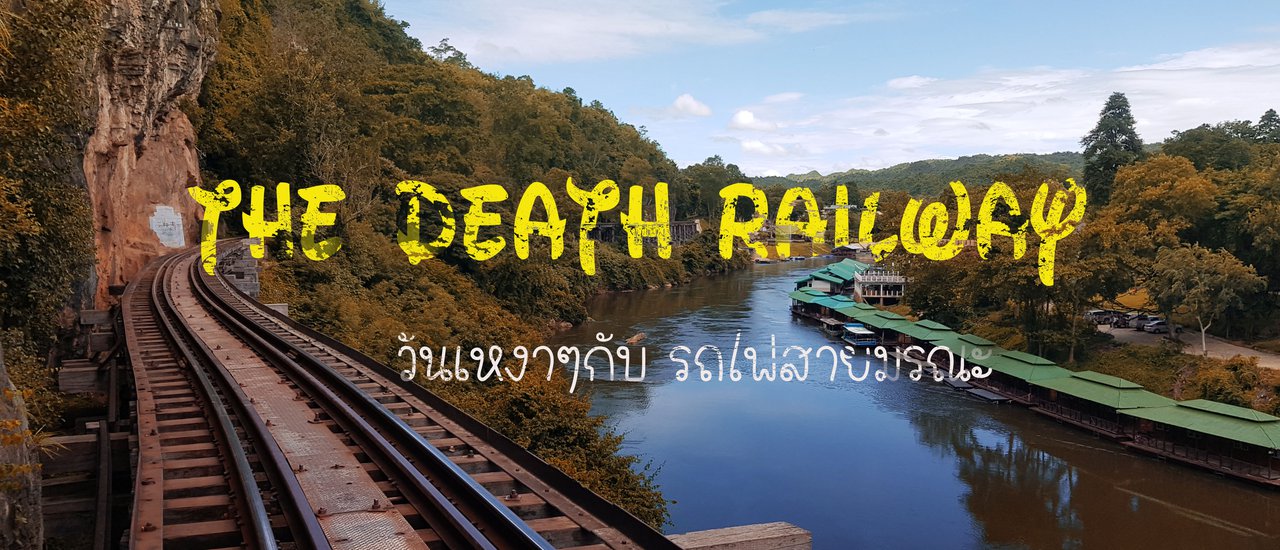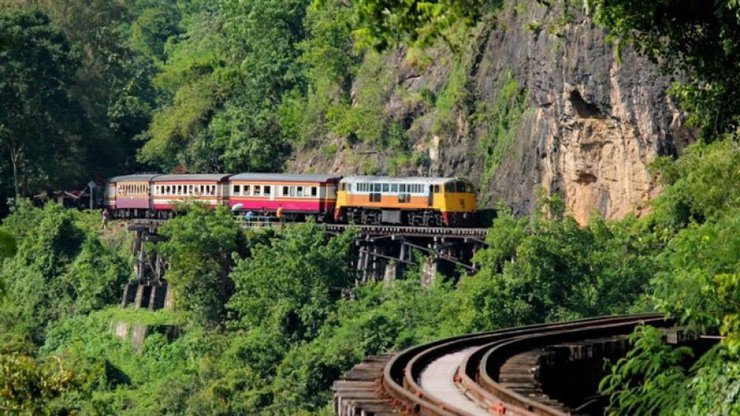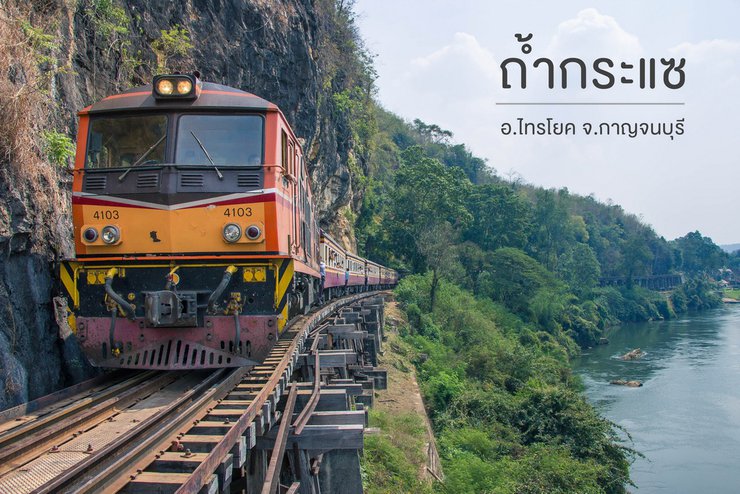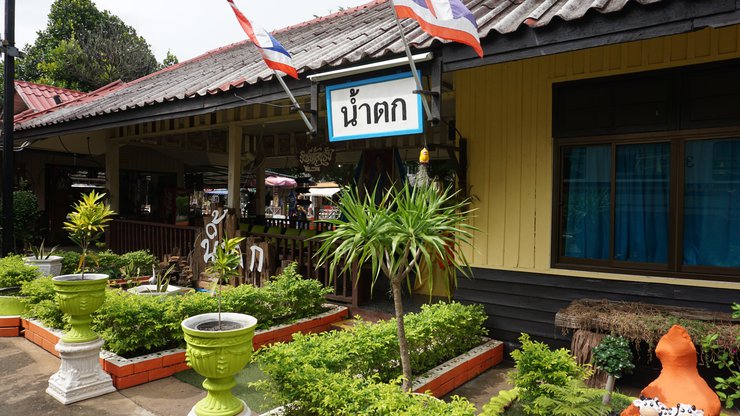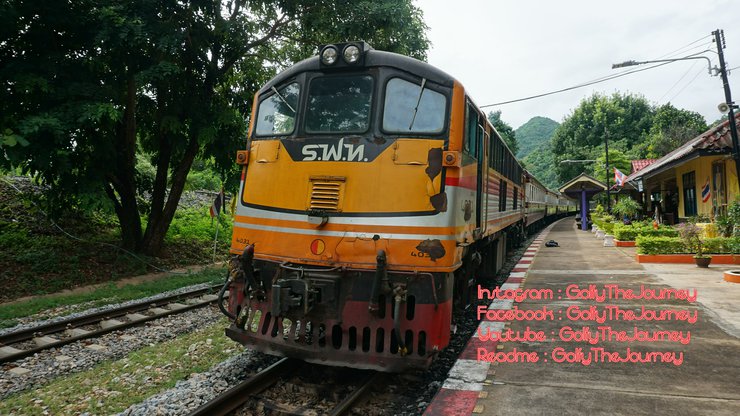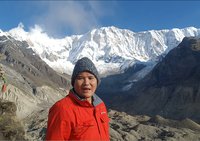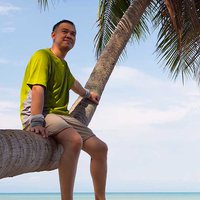
This review is part of my work. I have had the opportunity to visit Kanchanaburi many times. Today, I would like to share my experience at the Death Railway/Krasae Cave.
Note: The translation focuses on the main points of the original text while maintaining a simple and concise tone.
Trains are a convenient way to travel to Kanchanaburi Province, passing through important points in the city. We can stop and visit the city center as the last stop, making it convenient to travel back to Bangkok.
Thon Buri - Waterfall
Please Translate:

Waterfall - Thonburi

If you have extra time, you can visit the Trai Yok Noi Waterfall, which is the last station. For those who want to see the atmosphere of the Death Railway Bridge, if you take the train from Bangkok at 7:50 AM, you will arrive at Tham Krasae Station around 12:00 PM. There may be some delays on some days.
There are no public transportation options, such as buses or songthaews, available to reach Tham Kra Sae. If you do not have your own vehicle, the only way to get there is by train. Therefore, it is crucial not to miss the train.

For this trip, I chose to travel by train from Nam Tok Station.

I opted to travel on the last train of the day, which was scheduled to pick up any remaining passengers at 3:15 PM. My train's final destination was **Nong Pla Duk** railway station.

Tickets secured! Let's board the train.

All seats are on the 3rd floor. You can choose any seat you like.

I opted for the wooden cabinet on the right side of the train. It was truly exquisite.

The other queues were like this, a bit newer. That day, there were fewer travelers, mostly foreign tourists rather than Thai people.

The number of people increased after a while, mainly Western tourists.

Enjoy the scenery along the way.

After about 20 minutes, the train will start to climb the mountain, offering stunning views of the Mae Nam Khwae Noi River.

I was near the last booth, so I got a lot of beautiful views.

Stop at Wang Pho Railway Station, the last station before Tham Krasae Cave.

After a 30-minute train ride, we will arrive at Tham Krasae Railway Station.

A popular tourist destination is the Khao Kaeo Cave.

Khao Kaew Cave
Located in Lumphun Subdistrict, Sai Yok District, Kanchanaburi Province, approximately 55 kilometers from the city center. The Tham Krasae train stop is located on the Death Railway line, near the Tham Krasae Bridge, a wooden bridge along a cliff face that is over 450 meters long. Due to its location adjacent to the cliff face section of the railway construction, the cave is considered the most dangerous point on the route. The sharp curve along the mountainside with a deep river below earned it the nickname "Death Curve." The cave is adjacent to the railway tracks. Looking from the mouth of the cave towards the railway, one can see a beautiful view and the Khwae Noi River below. In the past, it is believed to have been a resting place for prisoners of war during the construction of the Death Railway from Thailand to Burma.

Tham Kra Sae is a small cave that houses a sacred Buddha statue. Visitors can enter the cave to pay their respects and pray to Luang Pho Tham Kra Sae, a large Buddha statue revered by locals and tourists alike.

After paying our respects and making offerings at the temple, we will proceed to explore the bridge.

Let's take a commemorative photo.

The Death Railway / Burma Railway / Kanchanaburi Railway
Constructed during World War II, the Death Railway was financed by the Japanese government with a loan of 4 million baht from the Thai government. The construction took only one year to complete. The railway was completed on October 25, 1943, and opened on December 25 of the same year. It served as a strategic route through Burma. The railway began at Nong Pla Duk Junction Station in Ban Pong District, Ratchaburi Province, passed through Kanchanaburi Province, crossed the River Kwai, and reached the Three Pagodas Pass to reach its final destination at Thanbyuzayat in Burma. The Death Railway had a total length of 415 kilometers from Nong Pla Duk to Thanbyuzayat Station, with approximately 303.95 kilometers in Thailand and 111.05 kilometers in Burma. It had 37 stations. The railway was built during World War II using forced labor from Allied prisoners of war, including British, American, Australian, Dutch, and New Zealand soldiers, totaling approximately 61,700 people, as well as Chinese, Vietnamese, Javanese, Malay, Burmese, and Indian laborers conscripted by the Japanese army. The railway was intended to serve as a passage to Burma for the transportation of weapons, military equipment, and troops to attack Burma and India, which were British colonies at the time. The construction of the bridges and railway was fraught with hardship, wartime atrocities, and disease, as well as food shortages, resulting in the deaths of tens of thousands of prisoners of war. The brutality, cruelty, and hardship endured by the prisoners of war led to the railway being dubbed the "Death Railway." The railway was completed on October 25, 1943, and opened on December 25 of the same year.

"The number of railway sleepers is equal to the number of people who died building the railway."

Following the end of the war, the Thai government paid 50 million baht to purchase the railway line from the British. They then repaired parts of the line, enabling trains to run from Nong Pla Duk Station to Nam Tok Station, a distance of approximately 77 kilometers from Kanchanaburi Station. The line has been operated by the State Railway of Thailand ever since.

Another highlight is the 400-meter walk on the Death Railway, which offers stunning views of the Kwae Noi River. This world-famous viewpoint is a must-visit for anyone traveling the Nam Tok Railway.

One day has passed. I would like to share the video I took.
Thank you for reading. Please like, share, and comment below.
Follow us for more updates.
https://th.readme.me/id/Golfythejourney
Golfythejourney's Instagram page
The sentence is already in English and does not require translation.
No text provided for translation.
The sentence is already in English and does not require translation.
Golfy The Journey
Wednesday, February 26, 2025 7:38 PM

